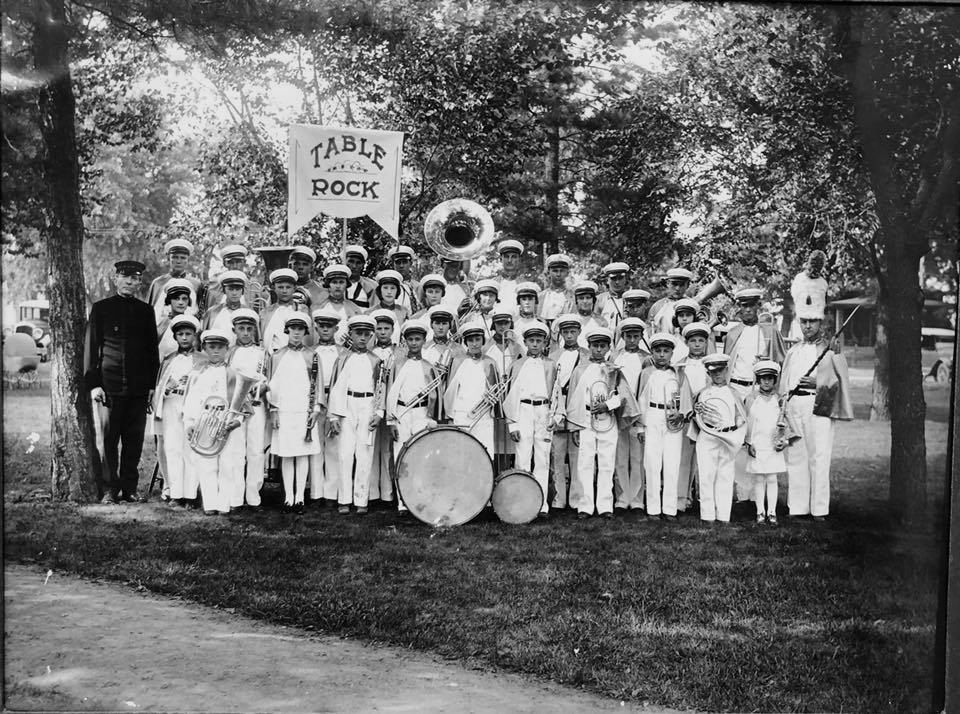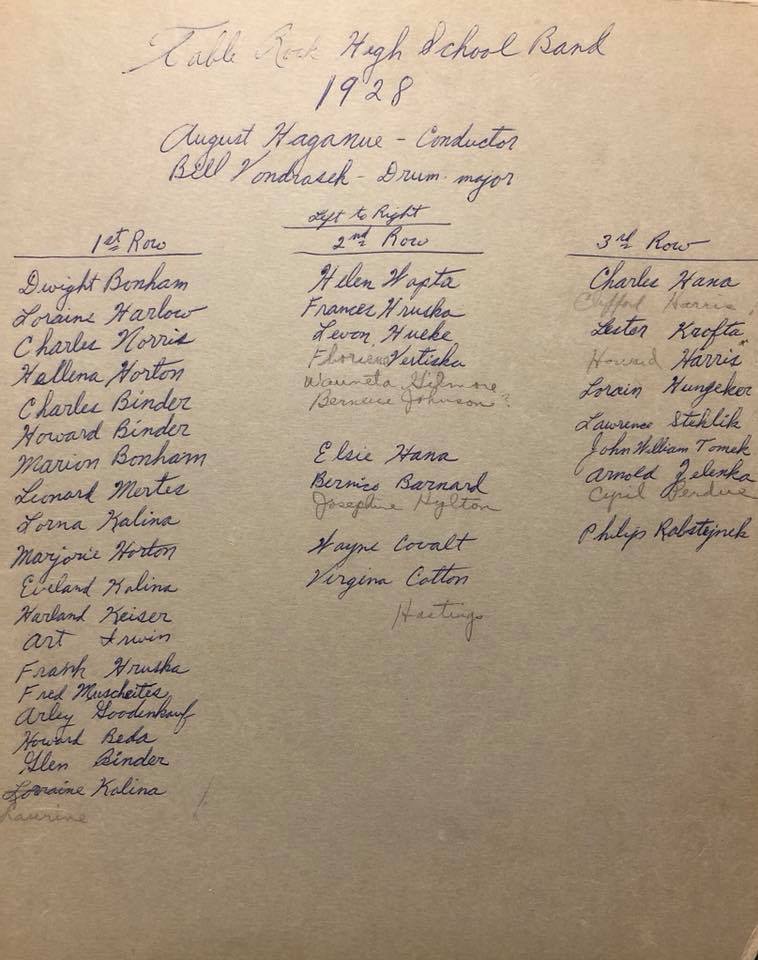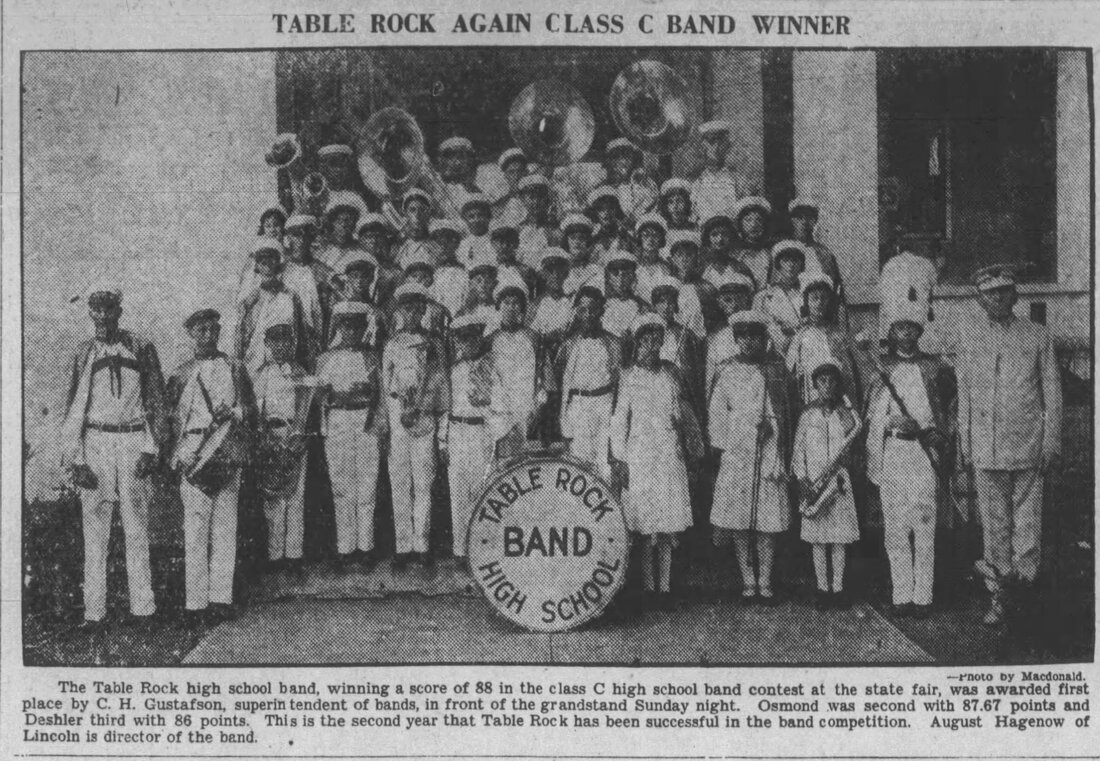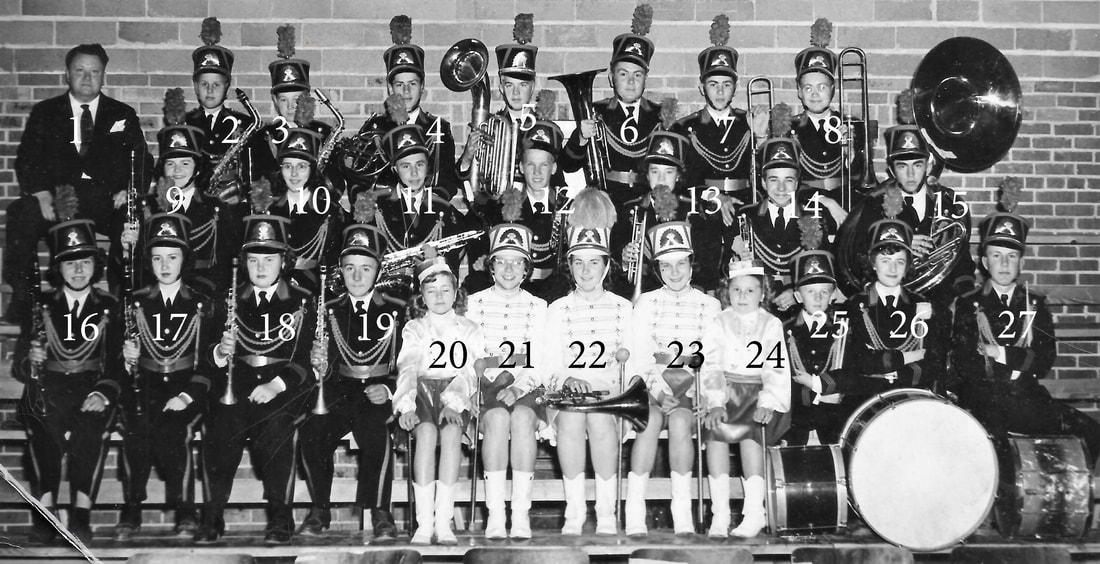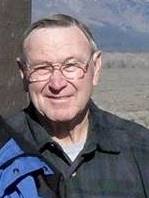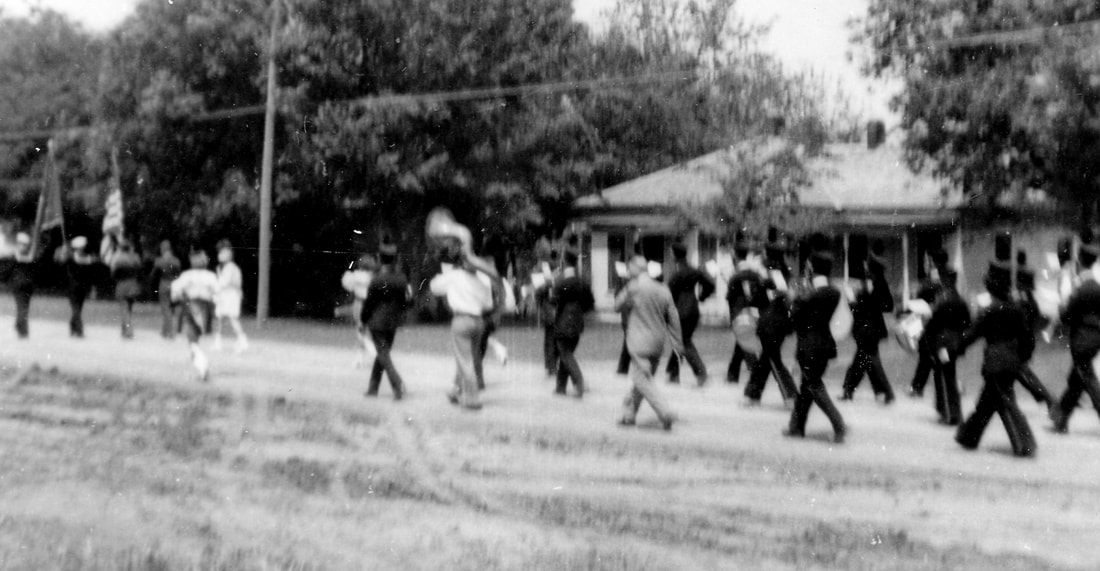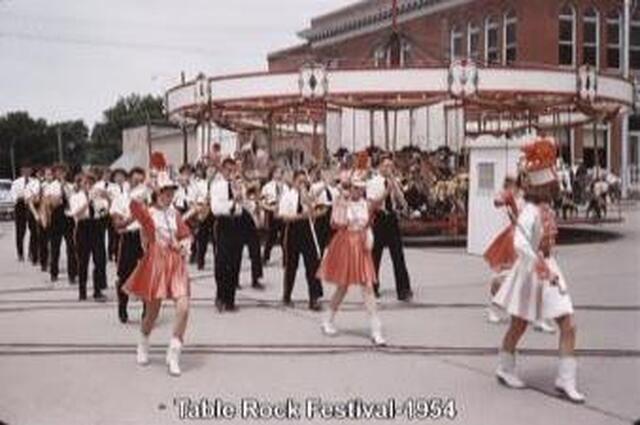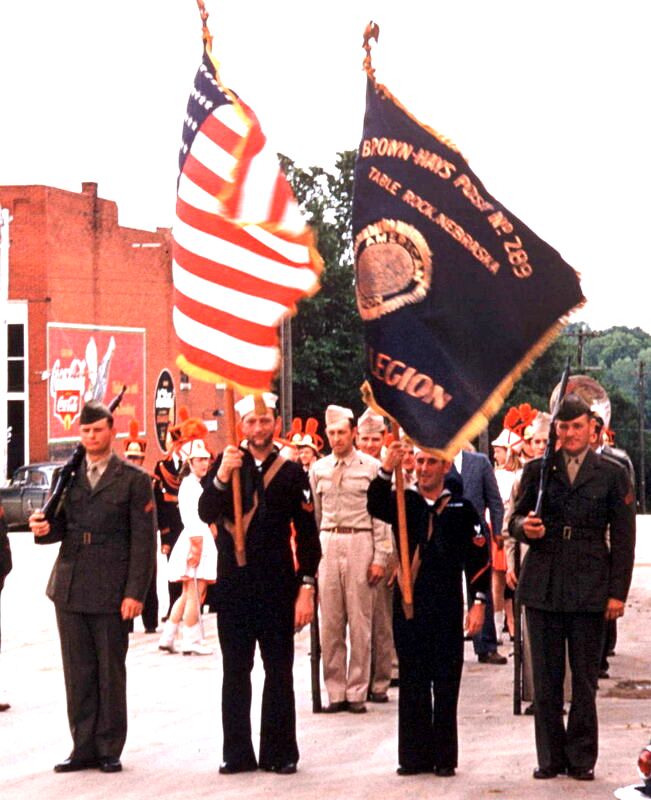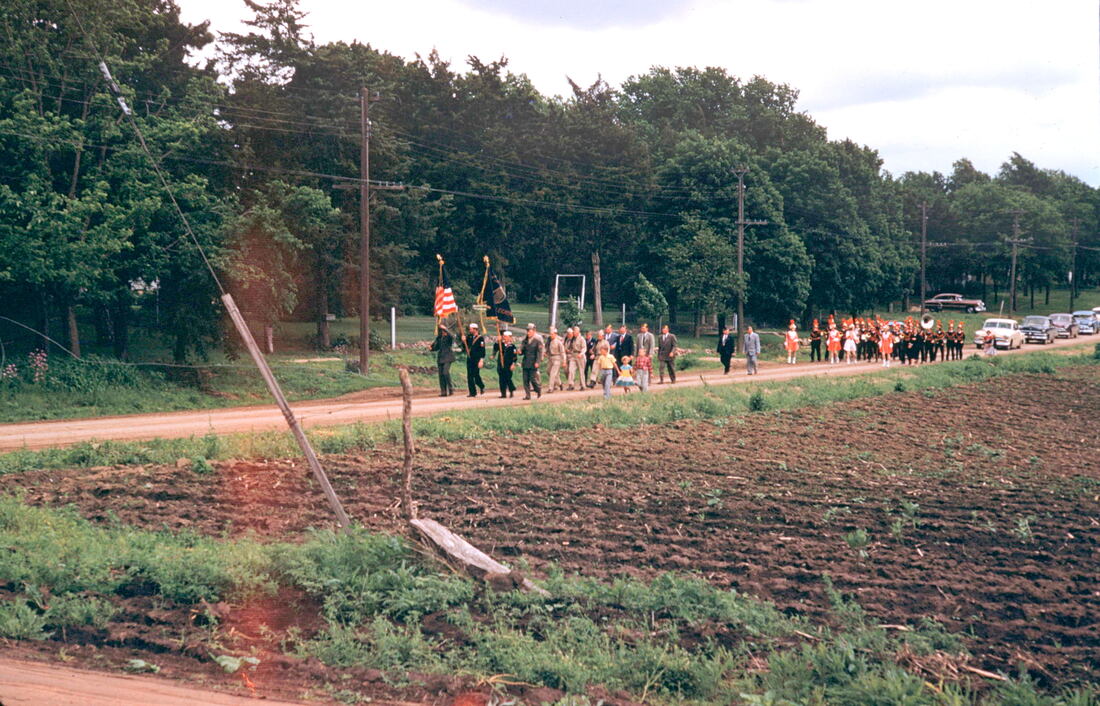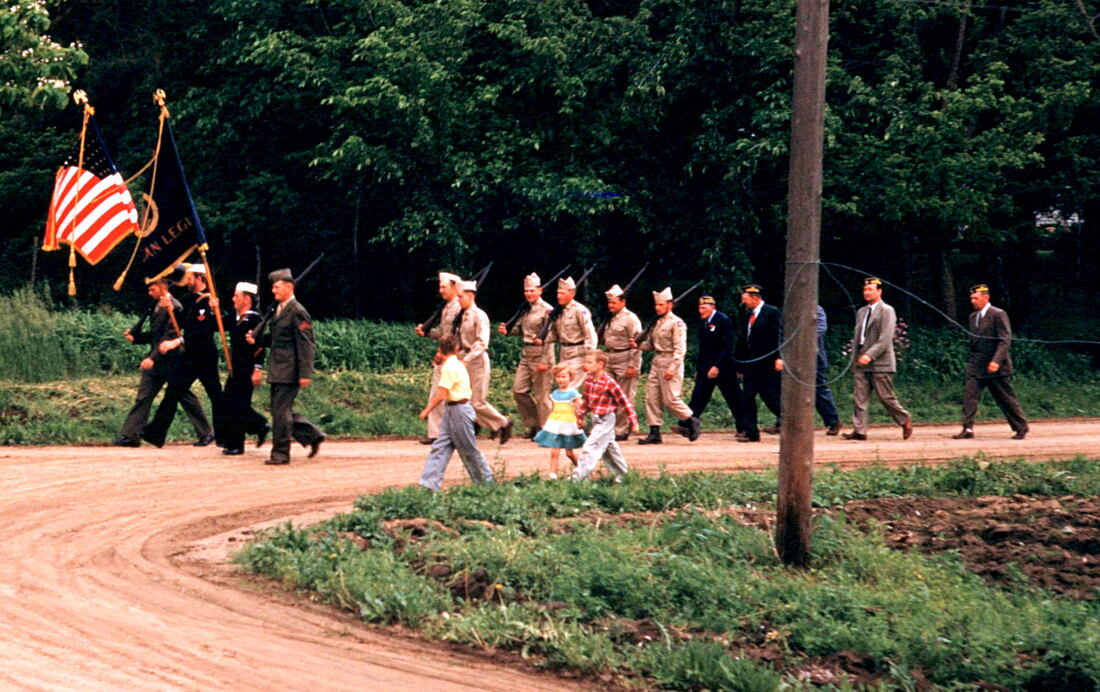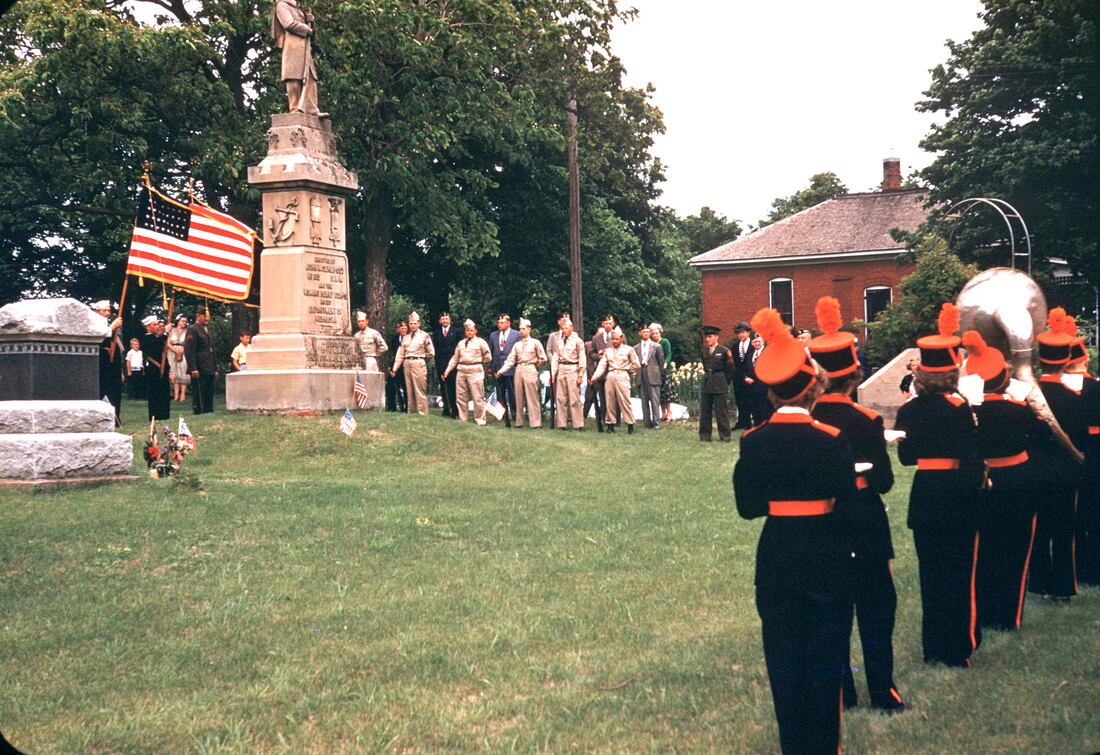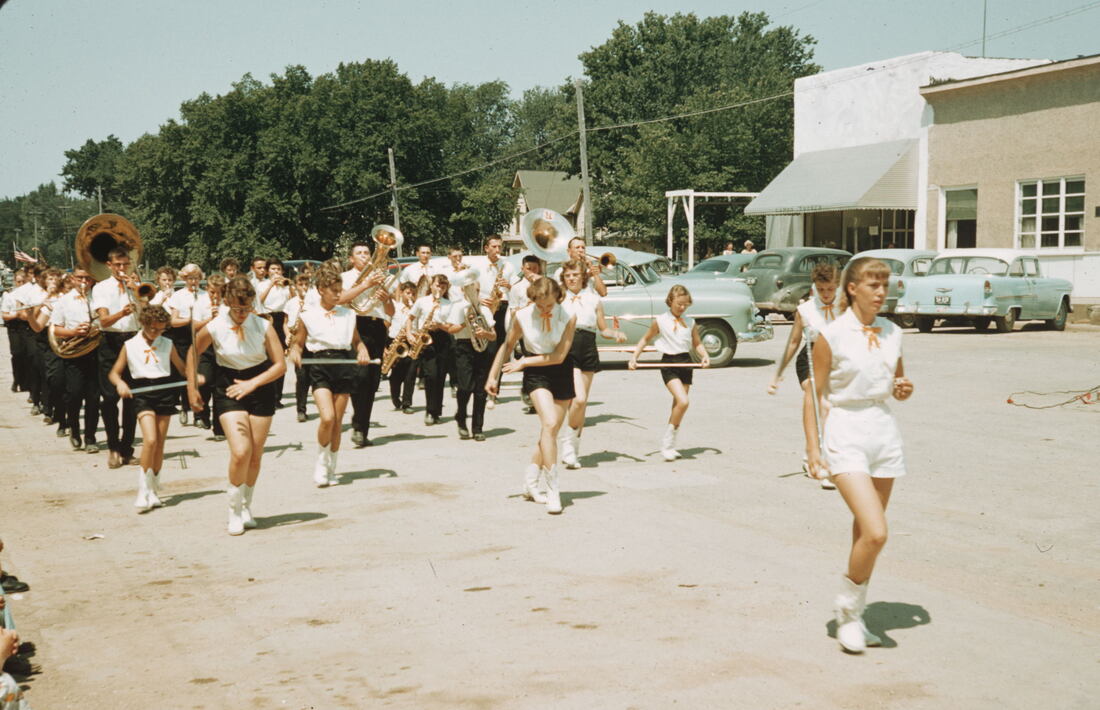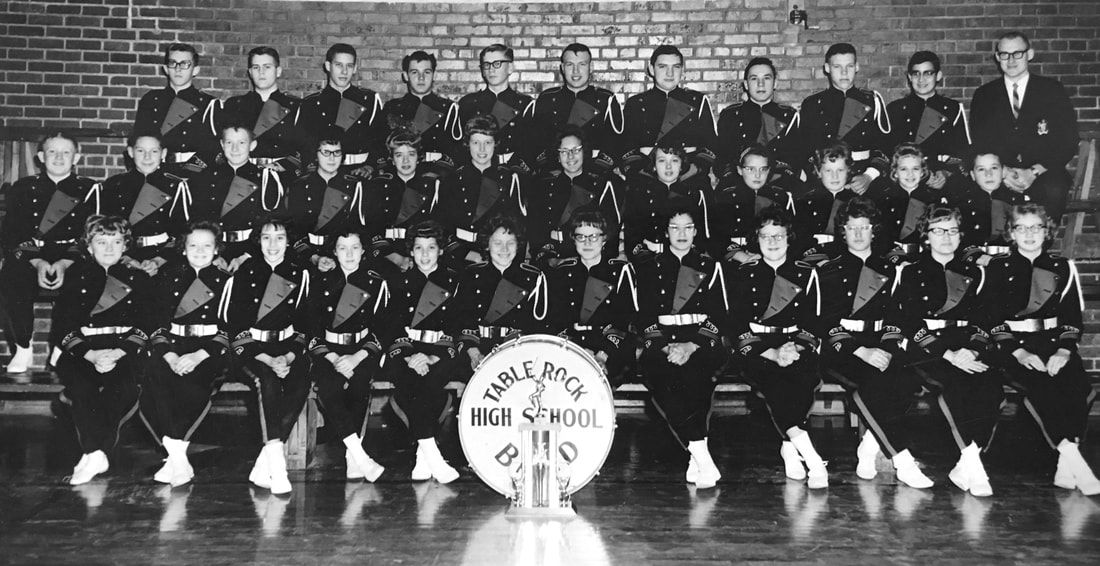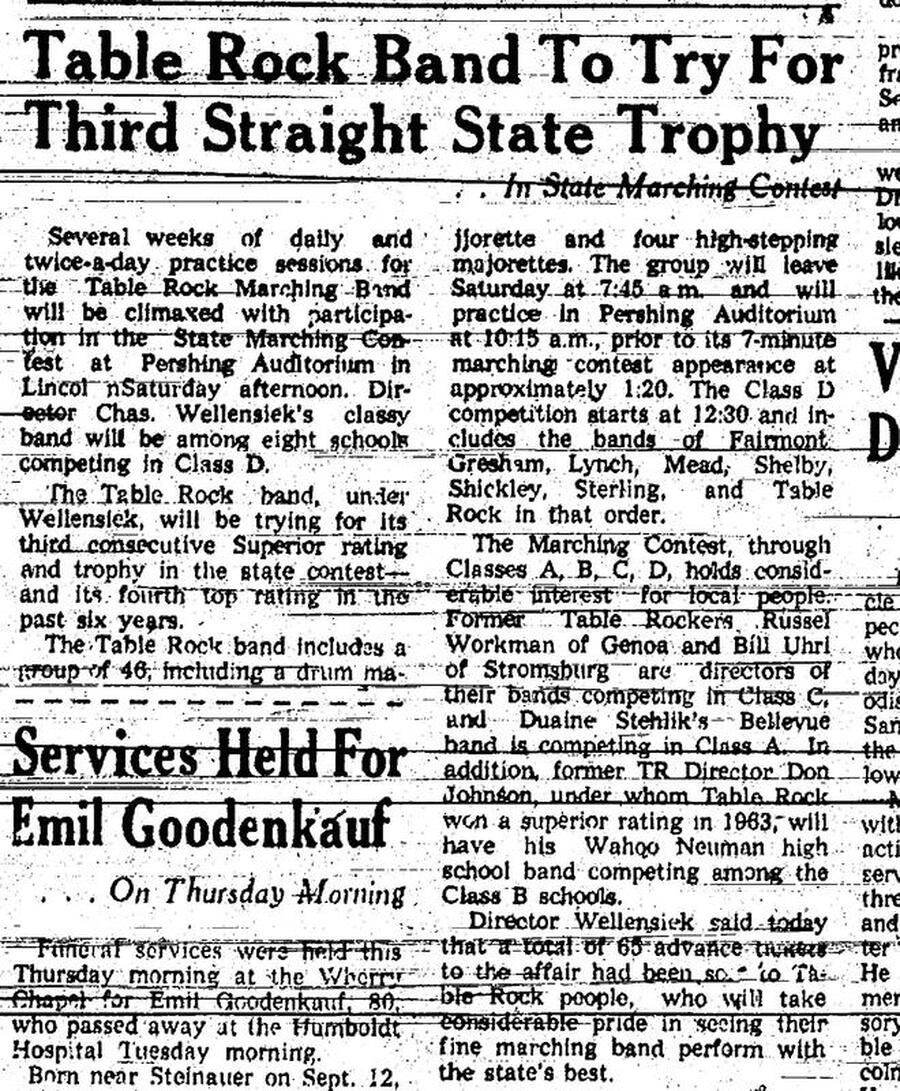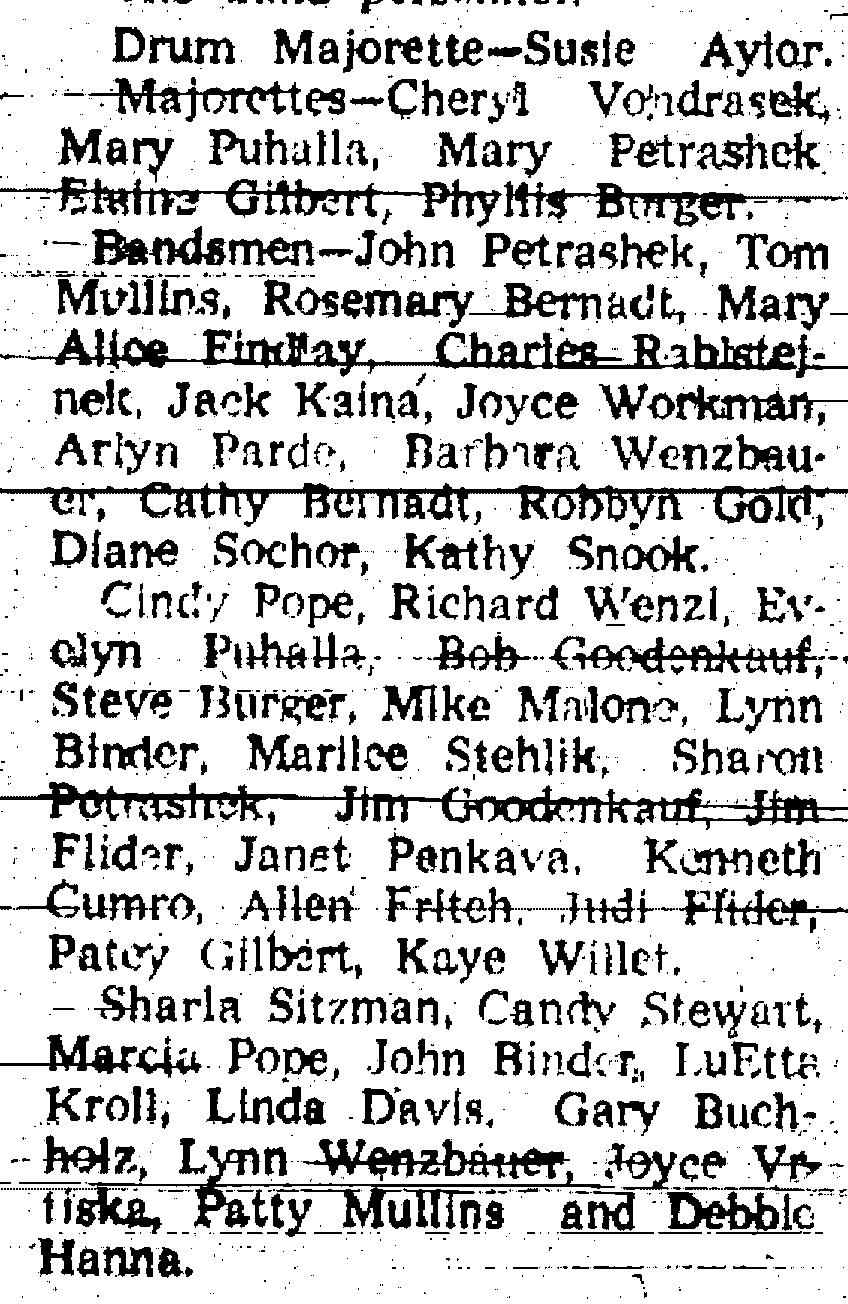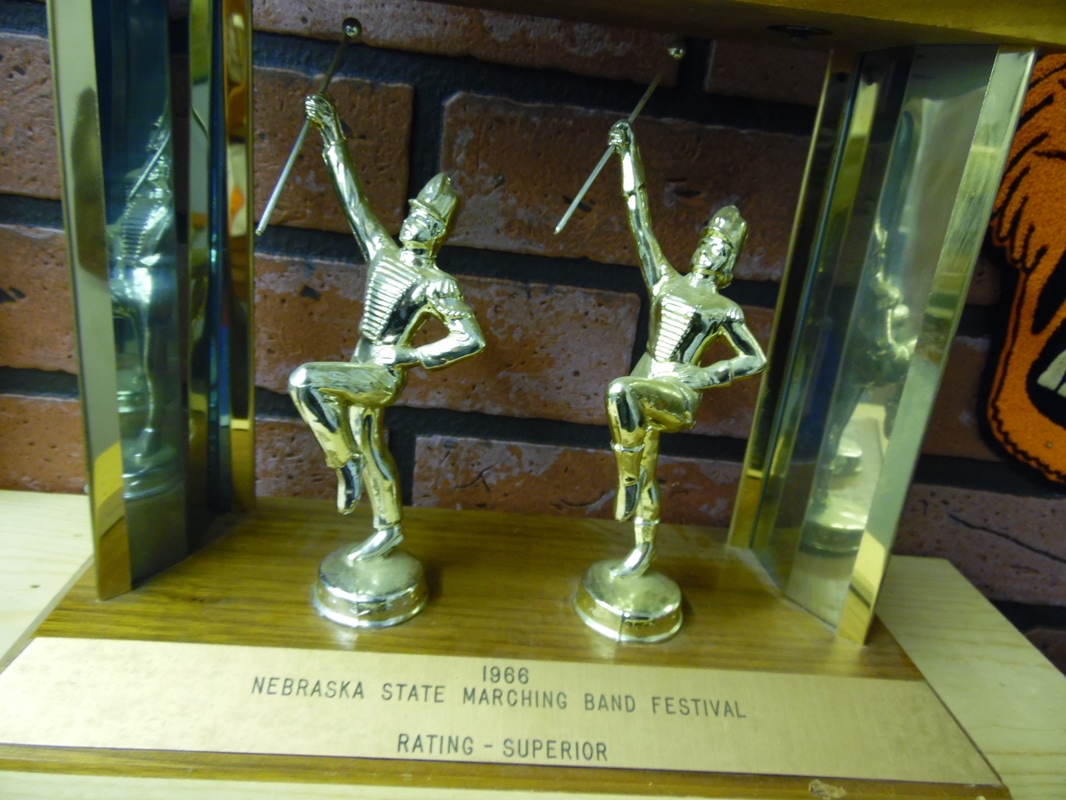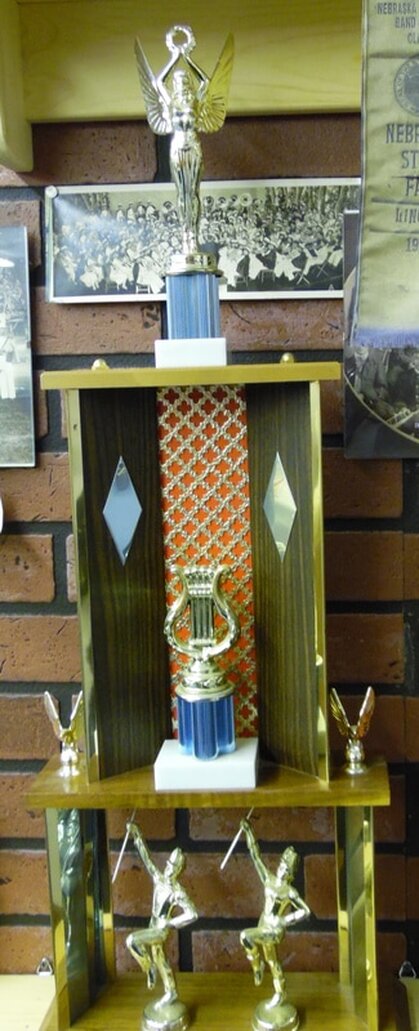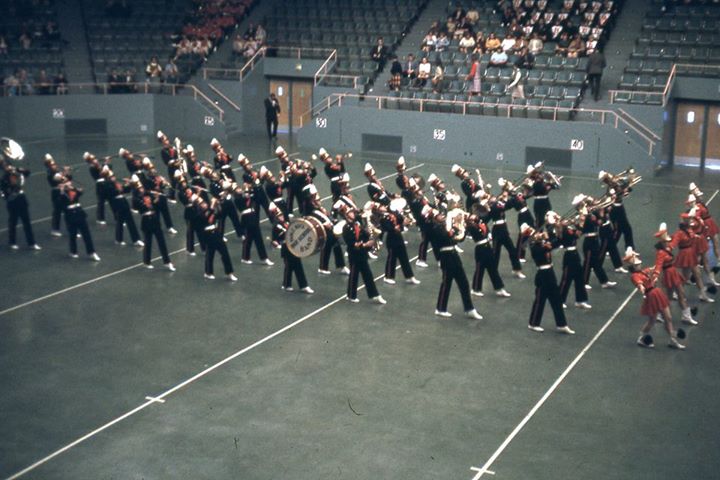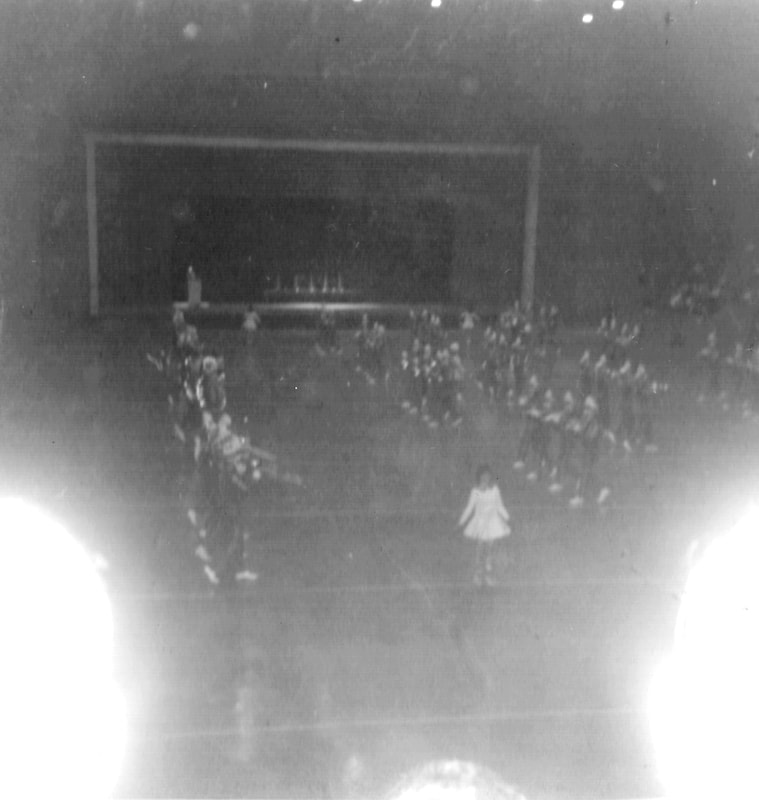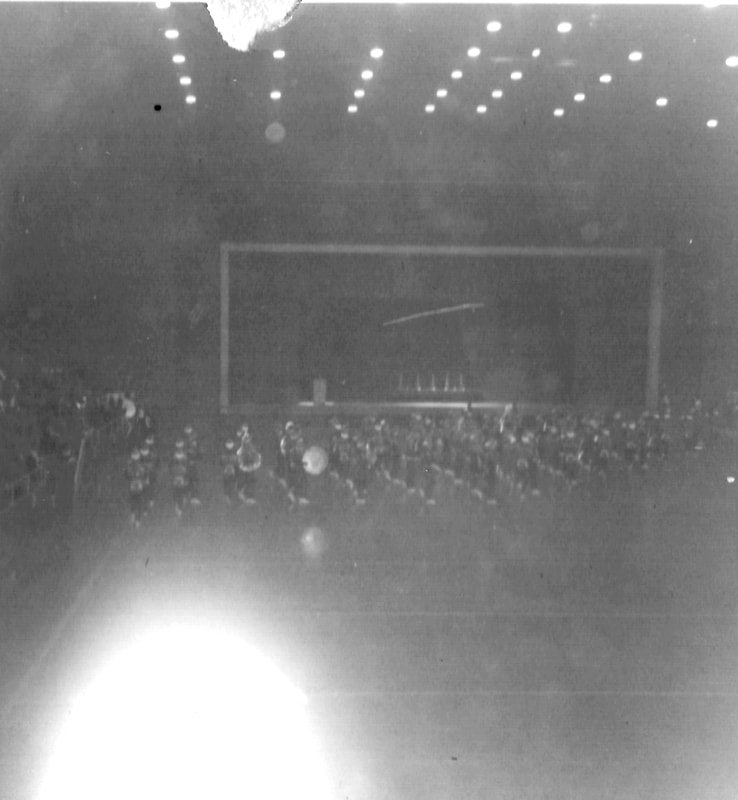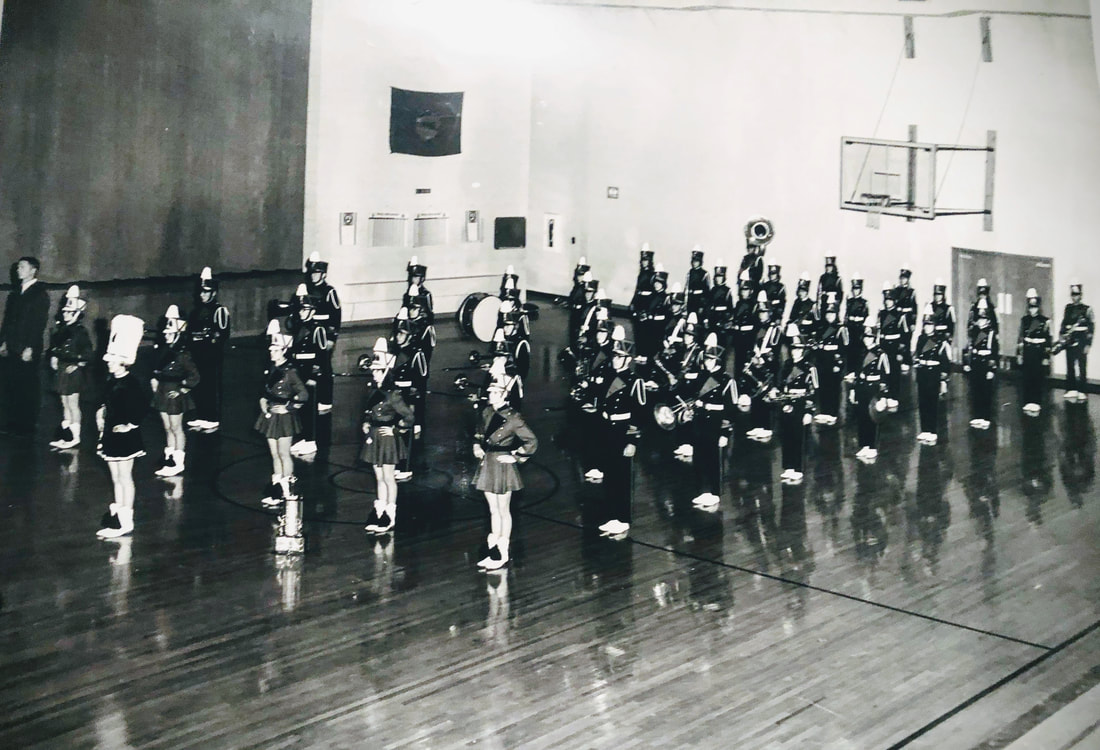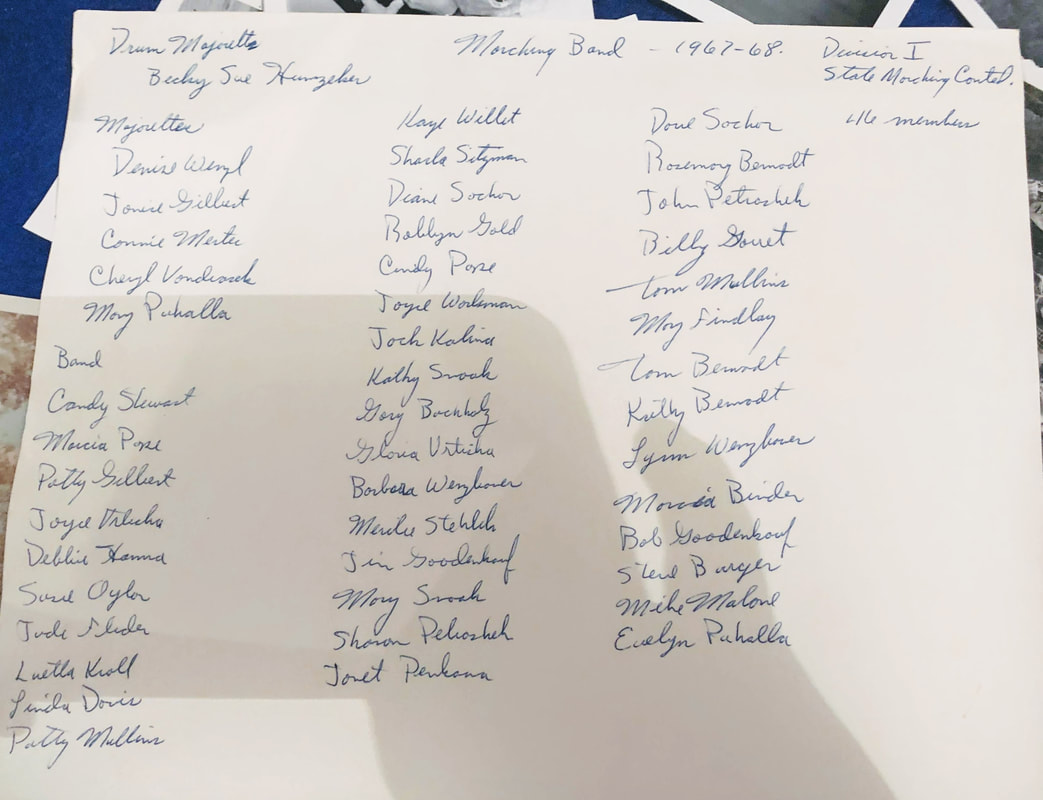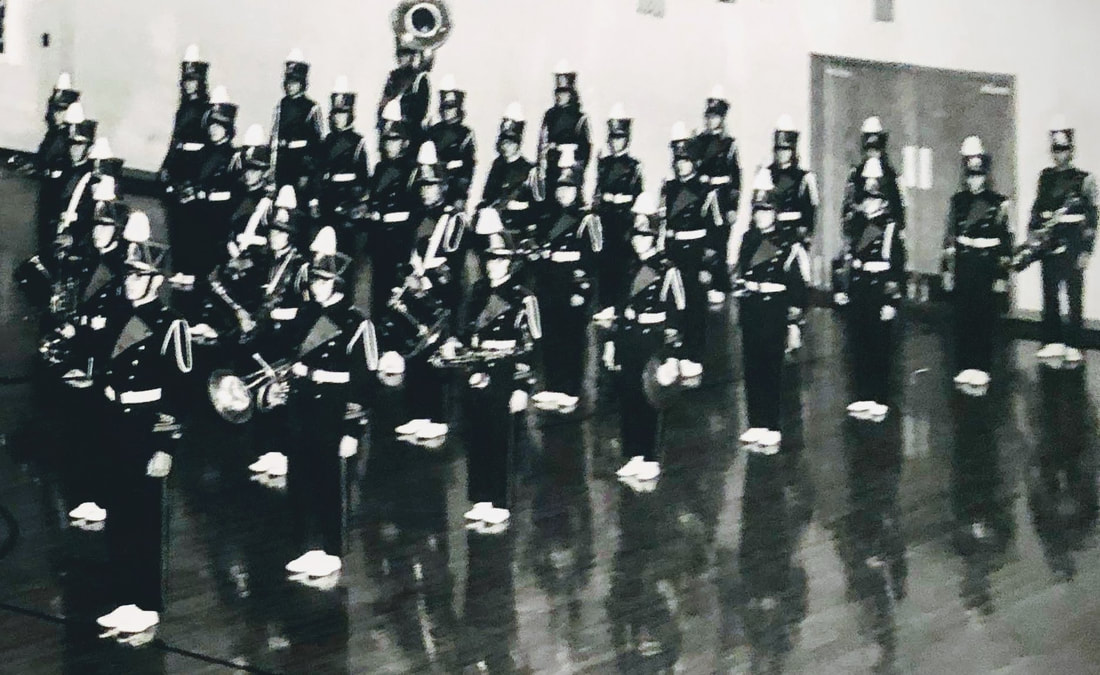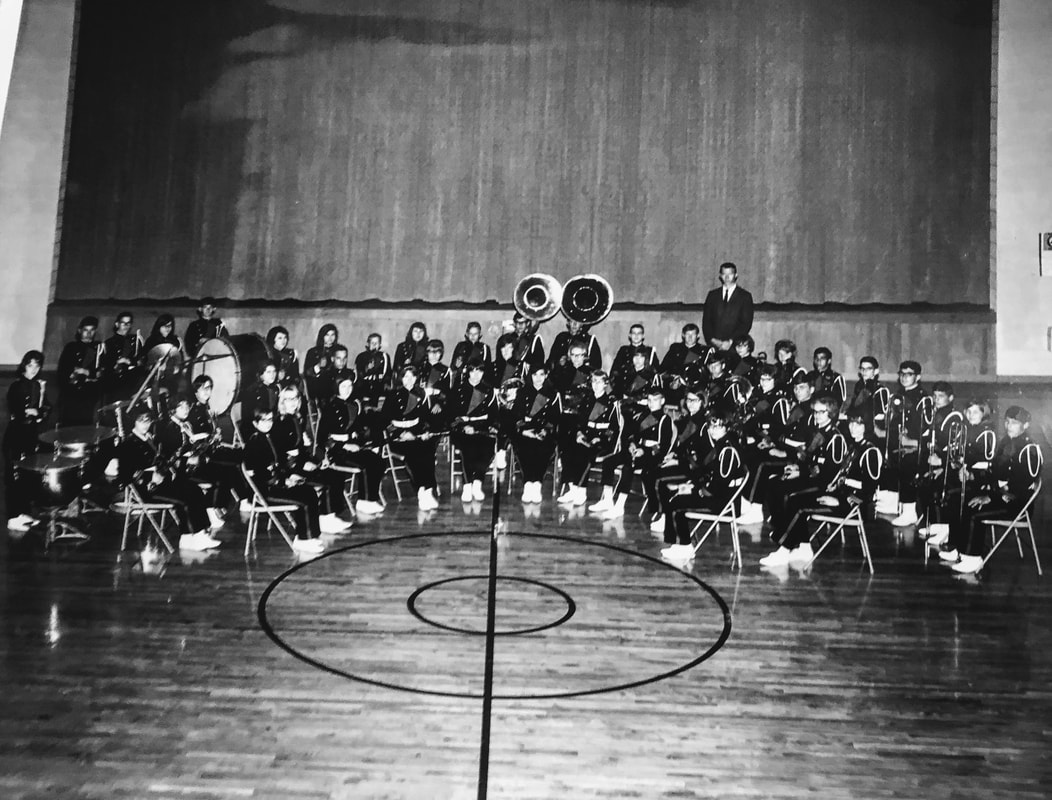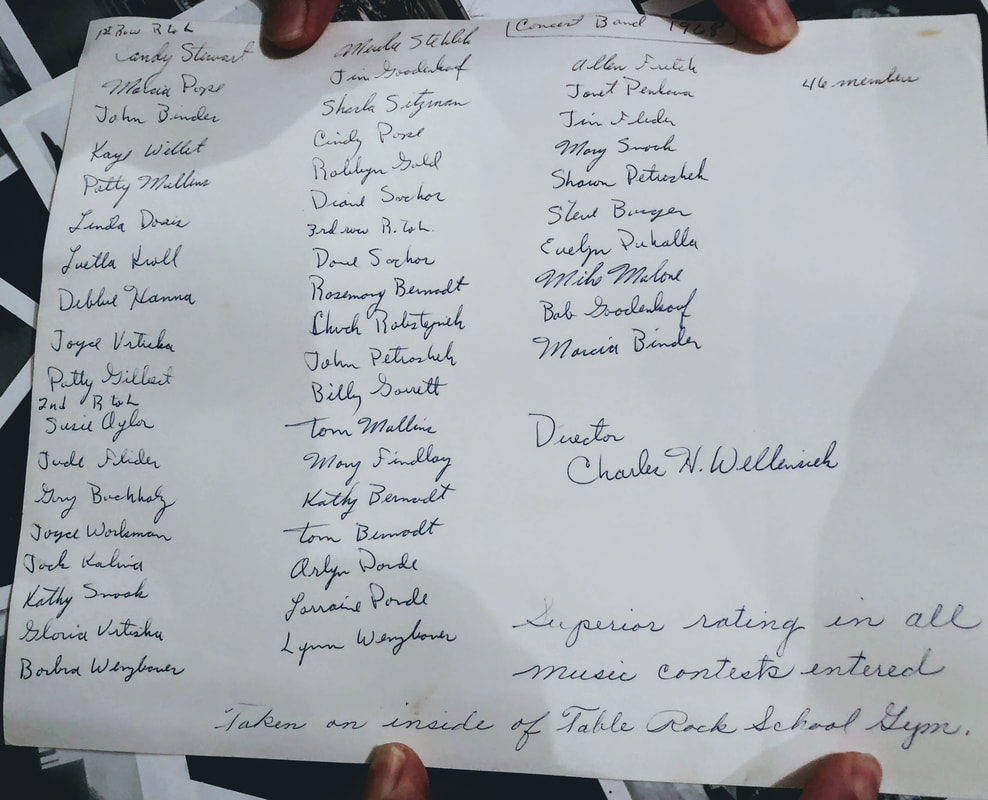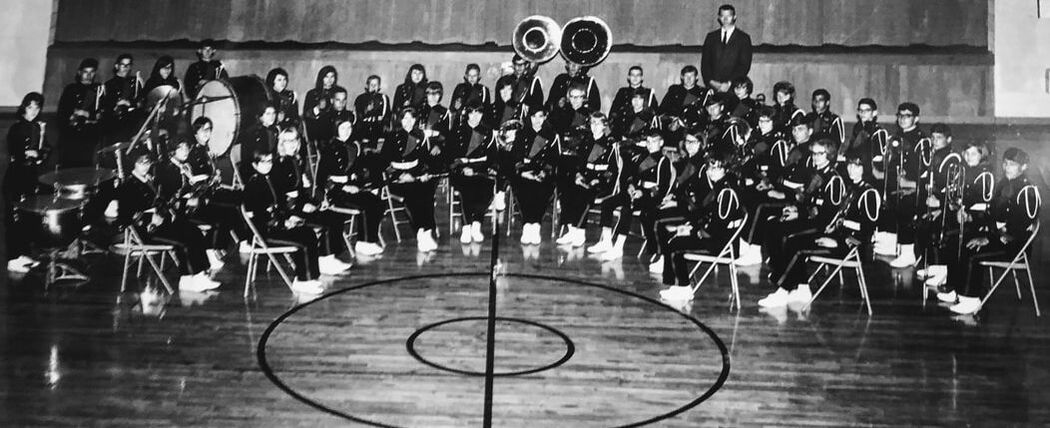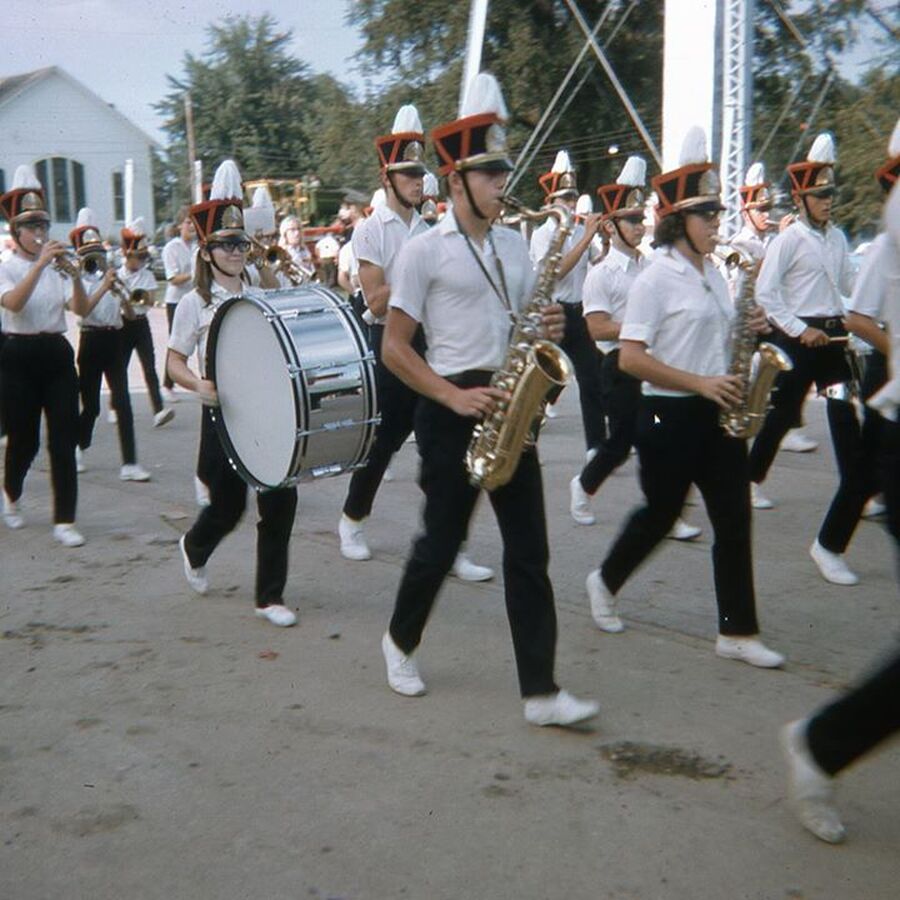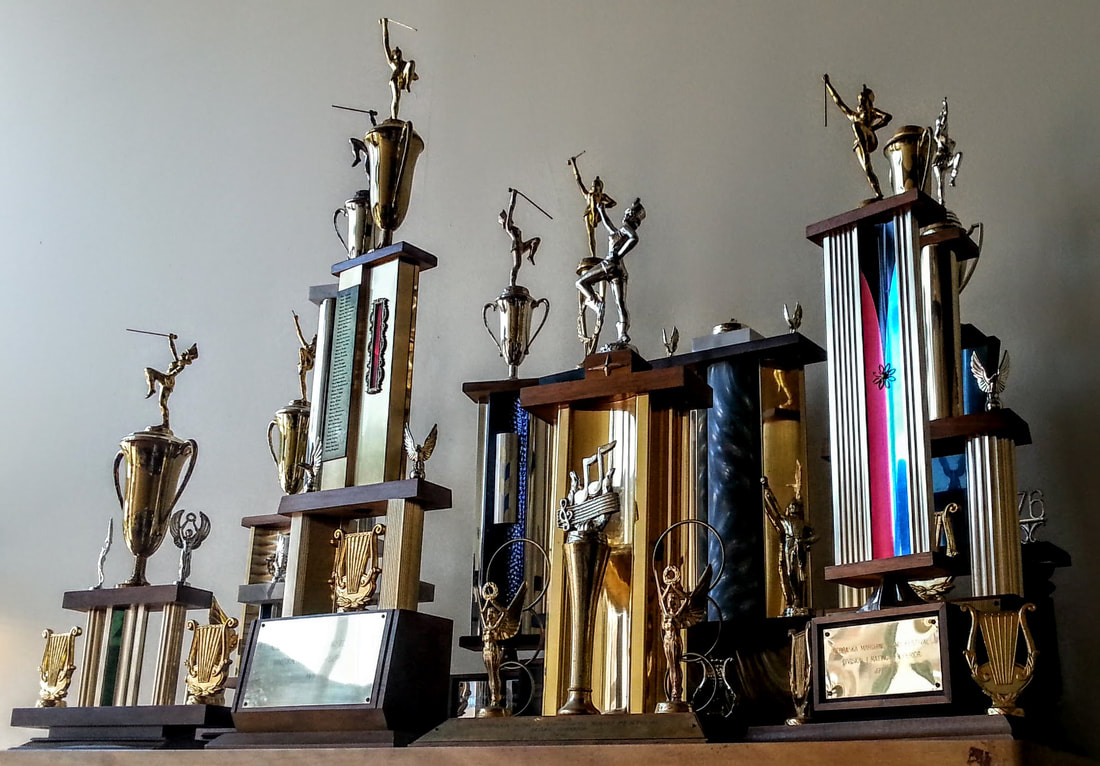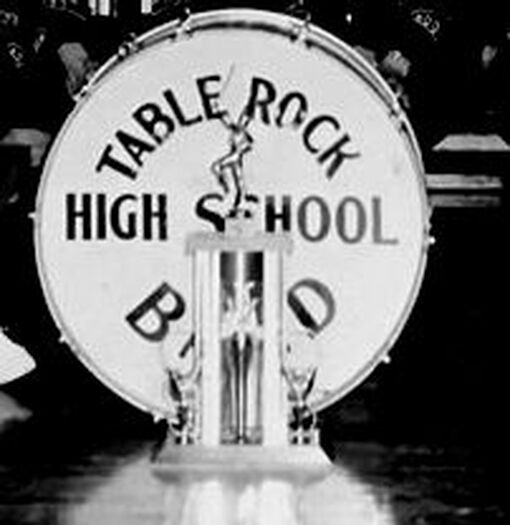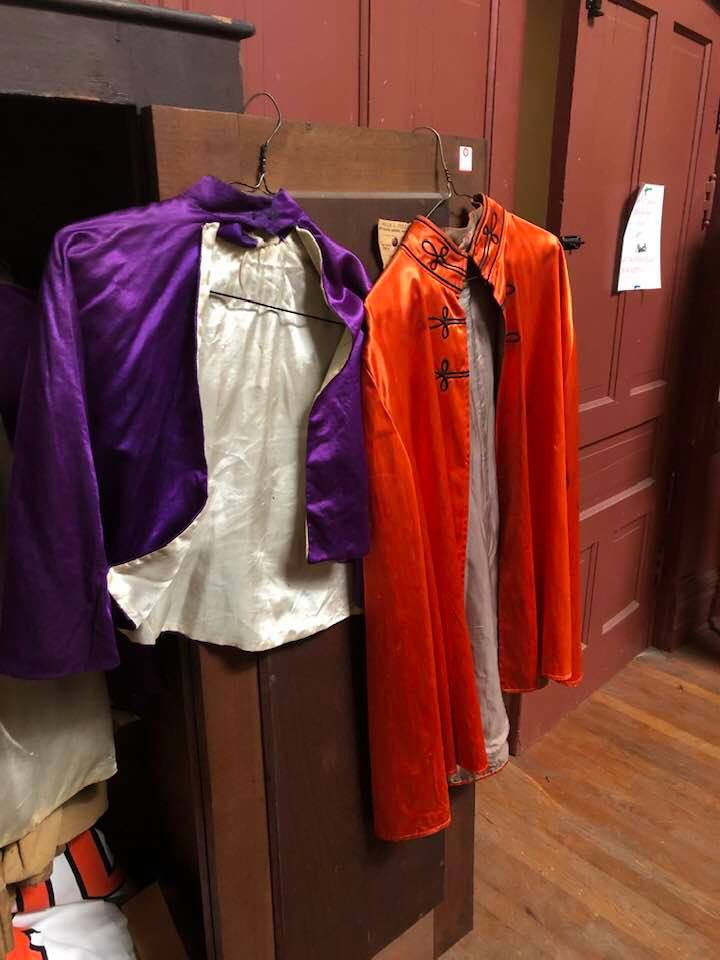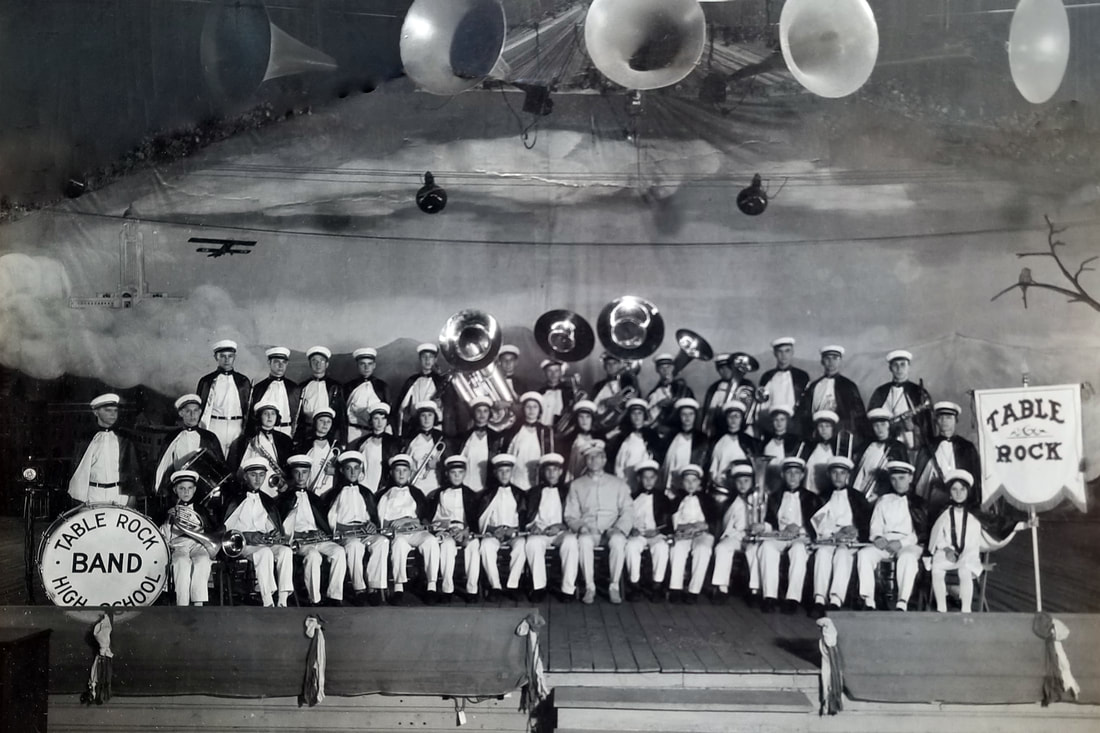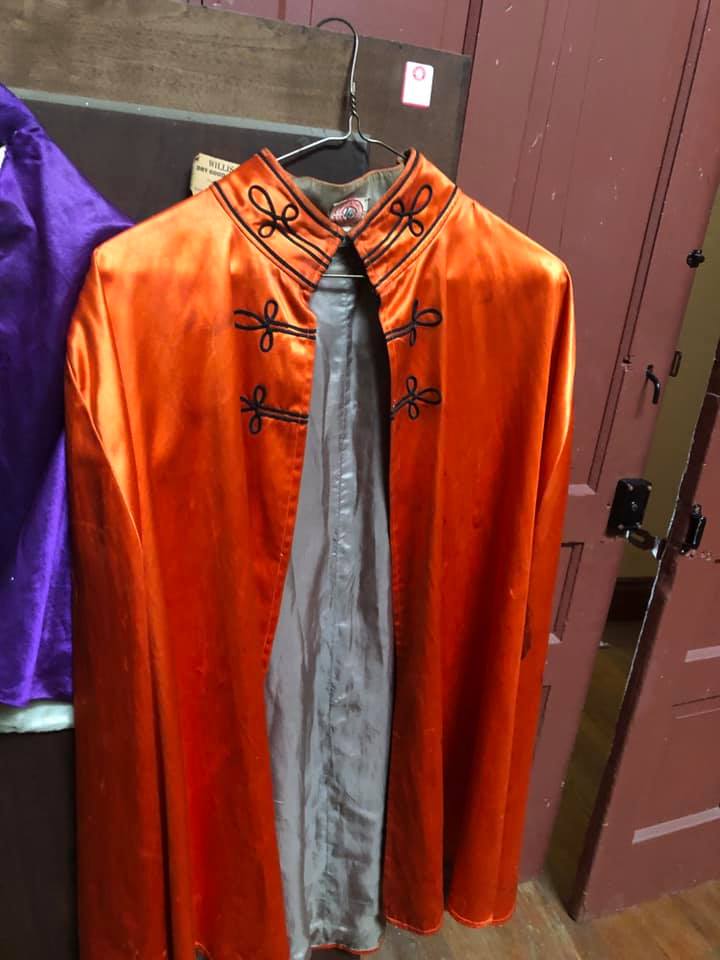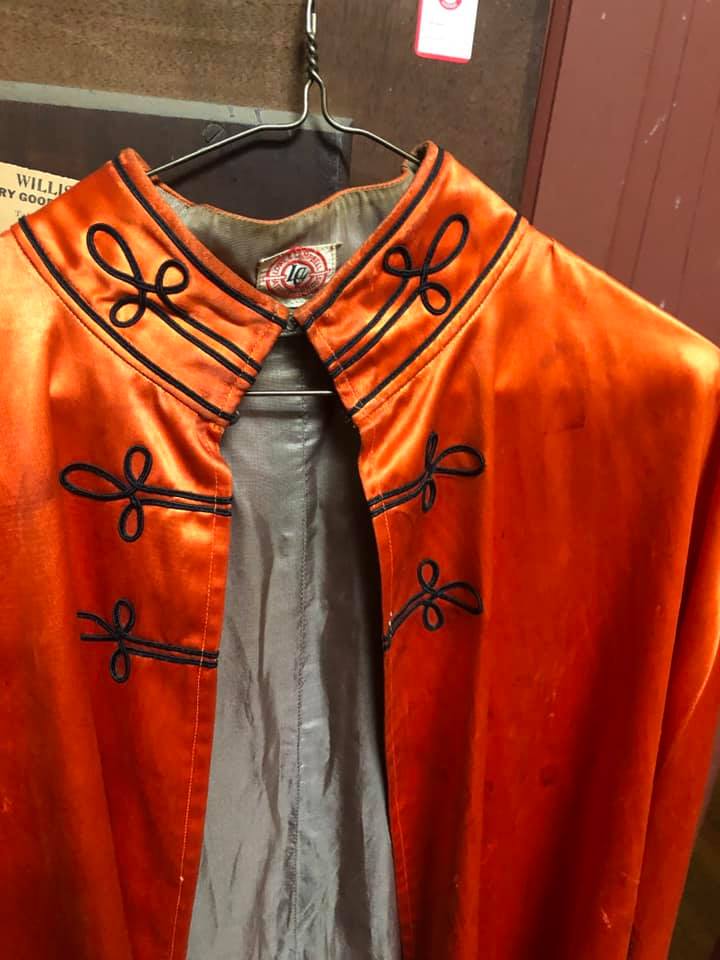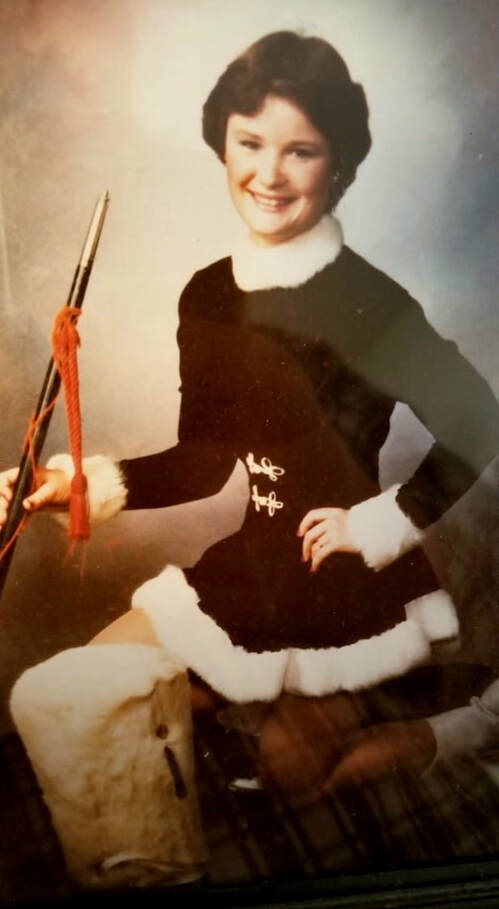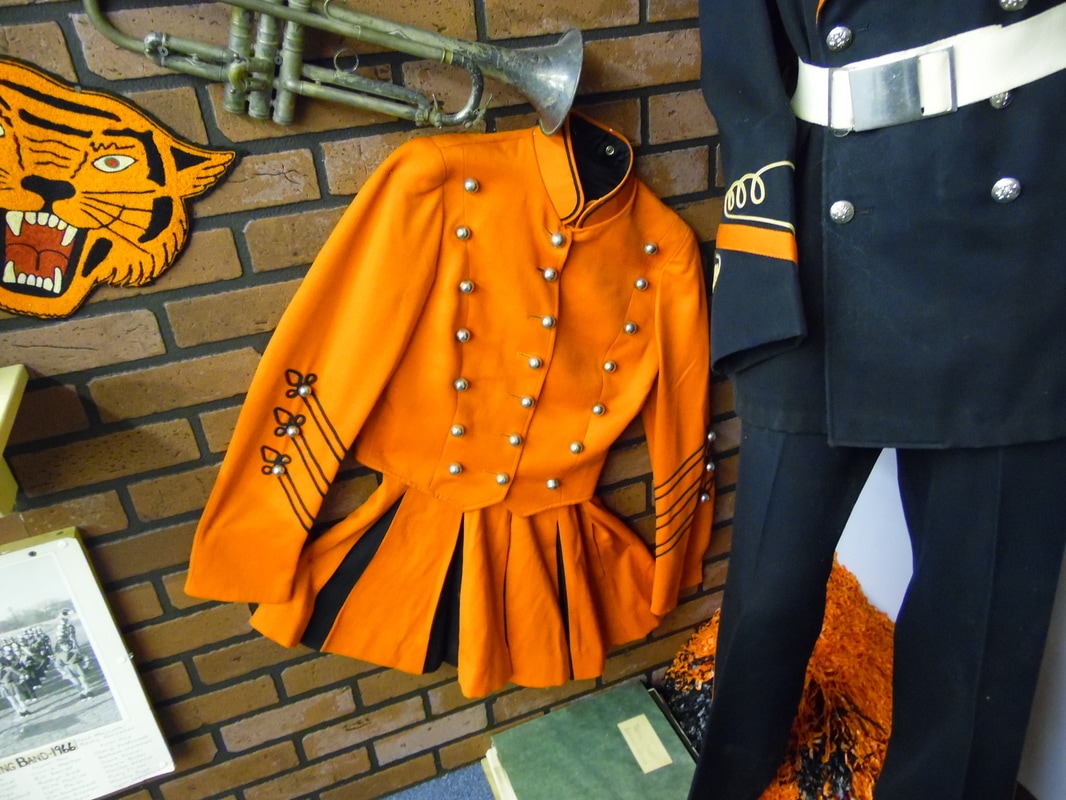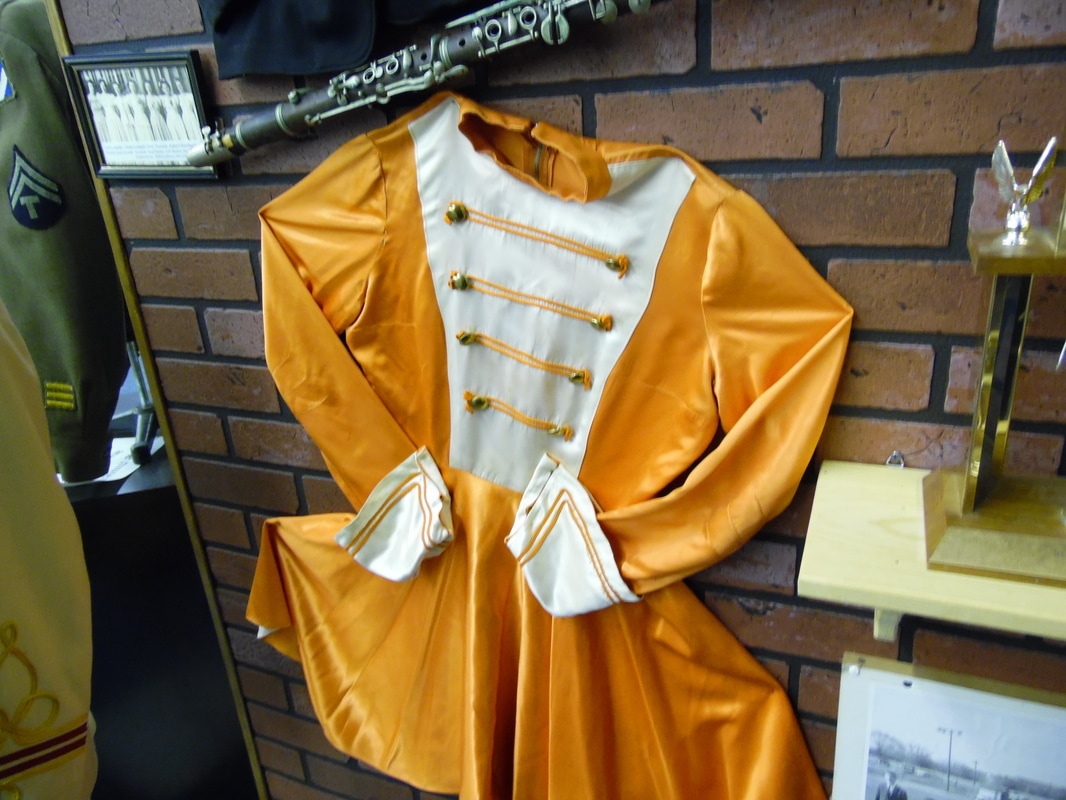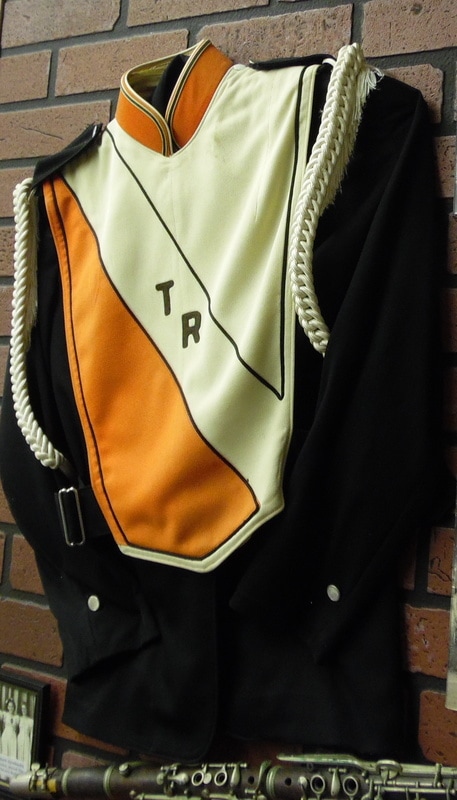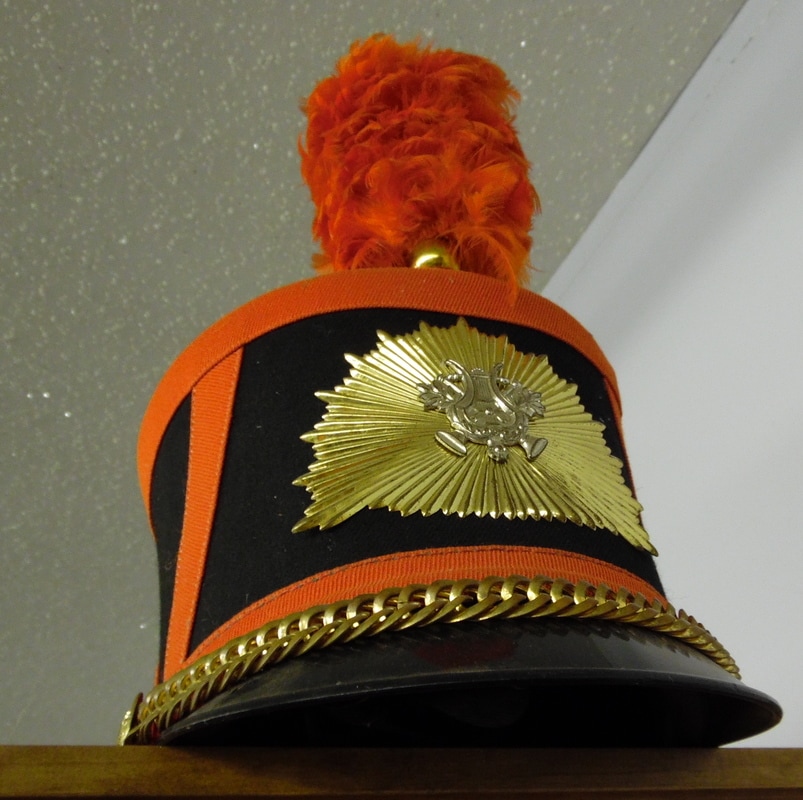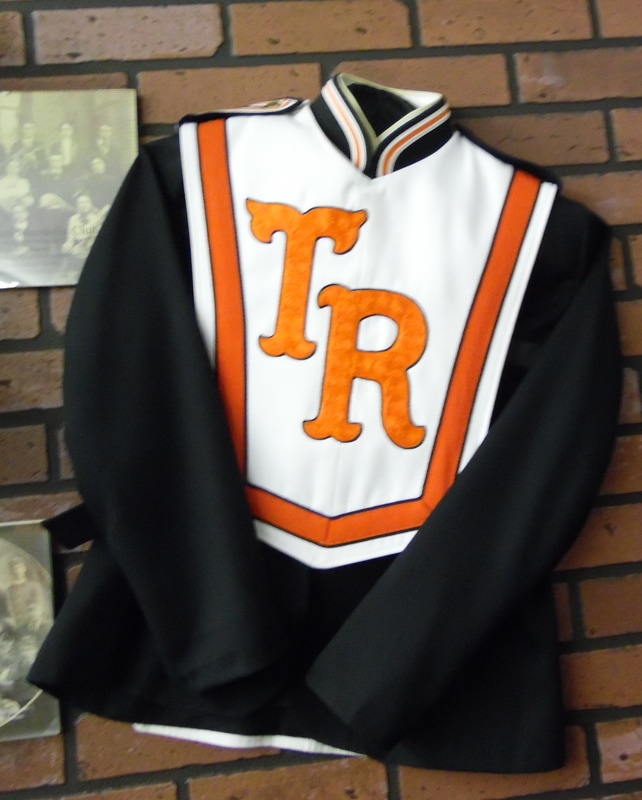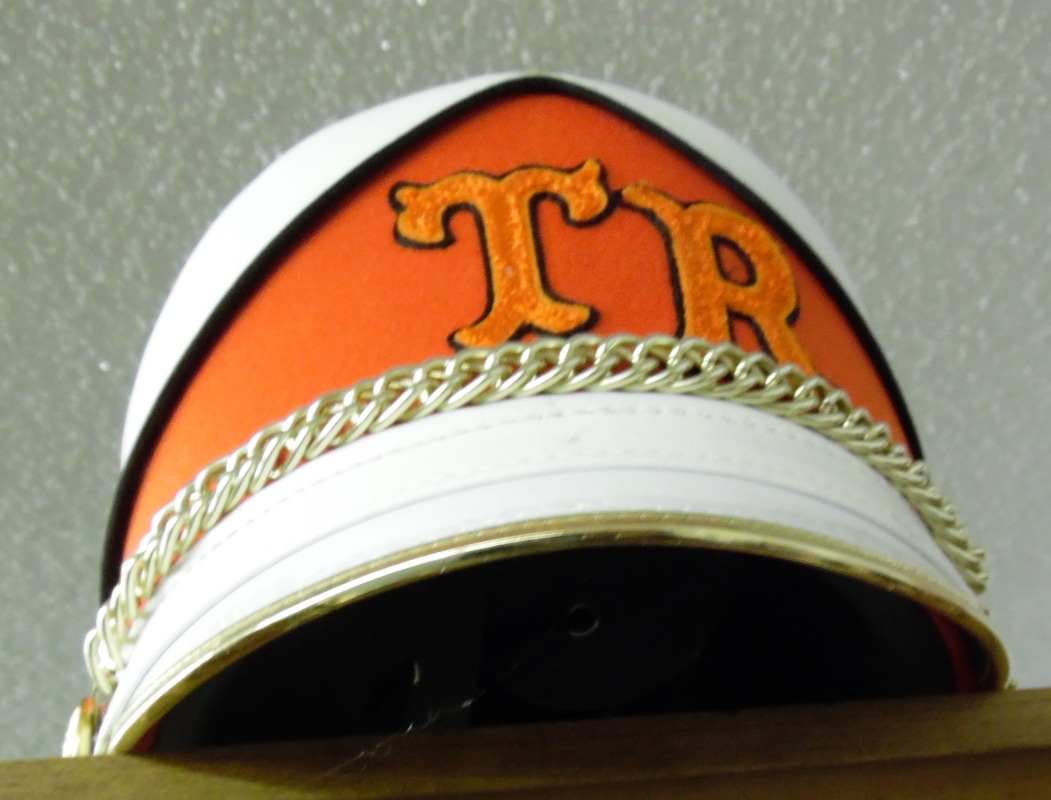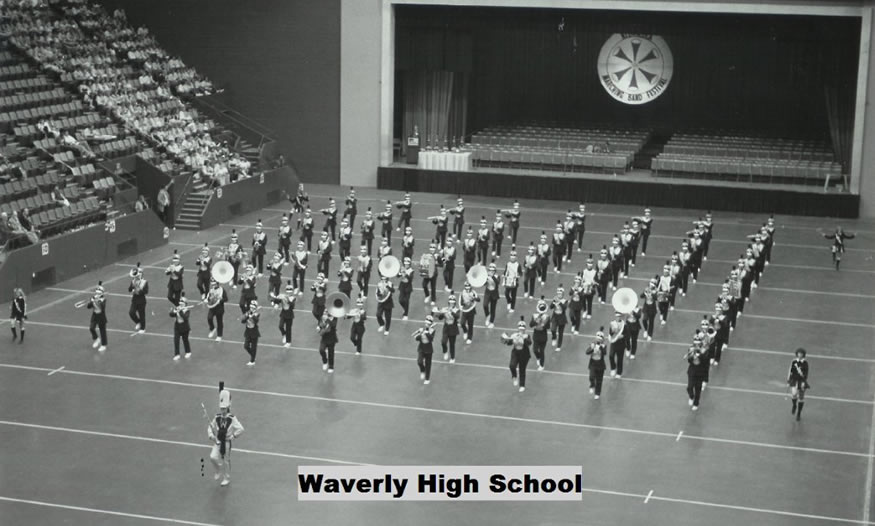school bands
a short history
This history comes from the Table Rock-Steinauer alumni book, written in the early 2000s, author unknown:
The first high school band was established in Table Rock in 1928 under the direction of August Hagenow. In 1929 and 1930, this band won first place in the state in Class C. In 1931, they won first place in Class A. Also in 1931-32, they won the Grand Championship of the State of Nebraska.
In 1963, the Table Rock Band won their first superior trophy in the Nebraska High School Marching Band Festival at Pershing auditorium in Lincoln.
Then, beginning in 1966, the Table Rock Band won nine consecutive superior ratings at Pershing, ending the string in 1974. That year, the band received special recognition for having tied the record for the most consecutive superior ratings received in that competition.
Familiar band instructor names from that era include: Johnson, Wellensiek, Patterson, Kubalek and Gunn.
The concert band was honored in 1985 as the outstanding Class D band by taped audition to perform at the Nebraska School Bandmasters Convention in Lincoln.
The stage band has been the only Class D stage band to rate superiors in 1982-83-84-85 in Southeast Nebraska. The stage band was selected to perform at the Nebraska State School Board convention in the fall of 1985.
The first high school band was established in Table Rock in 1928 under the direction of August Hagenow. In 1929 and 1930, this band won first place in the state in Class C. In 1931, they won first place in Class A. Also in 1931-32, they won the Grand Championship of the State of Nebraska.
In 1963, the Table Rock Band won their first superior trophy in the Nebraska High School Marching Band Festival at Pershing auditorium in Lincoln.
Then, beginning in 1966, the Table Rock Band won nine consecutive superior ratings at Pershing, ending the string in 1974. That year, the band received special recognition for having tied the record for the most consecutive superior ratings received in that competition.
Familiar band instructor names from that era include: Johnson, Wellensiek, Patterson, Kubalek and Gunn.
The concert band was honored in 1985 as the outstanding Class D band by taped audition to perform at the Nebraska School Bandmasters Convention in Lincoln.
The stage band has been the only Class D stage band to rate superiors in 1982-83-84-85 in Southeast Nebraska. The stage band was selected to perform at the Nebraska State School Board convention in the fall of 1985.
1928 - the first school band
|
Take a better look at this picture, follow this link:
|
1929
1930
1950s
school year 1949-1950
|
Names are from Bob Blecha and others who contributed when this was posted on Facebook in 2020
|
school year 1950-1951
summer of 1951
summer of 1954
memorial day weekend circa 1956-1957
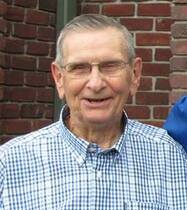 Edward Tomek
Edward Tomek
In days of yore, the veterans and the band would start from the Square and march to the cemetery. Edward Tomek took these photographs within a few years after he returned from service overseas.
CIRCA 1956-1957
1963
(school year 1963-1964)
In April 2020, Susie Aylor Sochor came up with this photo of the band and a trophy. She was not sure of the date. Someone pointed out that there were seniors in the picture, Class of 1964. That would make the picture from the Fall of 1963 -- the first win at Pershing! Susie knew most of the names, and others filled in the blanks, so we know who is who:
And the names!
|
Follow the numbers!
1 John Diehm 2 Dave Brewer 3 Mike Workman 4 Bill Uhri 5 Loren Joe Stehlik 6 Jim Bernadt 7 Robert Puhalla 8 Brian Goodenkauf 9 Terry Kalina 10 Mike Mullins |
11 Don Johnson -- Band Director
12 Lynn Meyer 13 Dave Sochor 14 Tom Bernadt 15 Kathy Mitchell 16 Jackie Flider17 Karen Wenzbauer 18 Janet Flider 19 Sharon Petrashek 20 Diane Sochor 21 Merilee Stehlik 22 Judy Flider |
23 Jim Goodenkauf
24 Donna Alderman 25 Patty Gilbert 26 Susie Aylor 27 Debbie Hanna 28 Candy Stewart 29Joyce Workman 30 Anita Jasa 31 Linda Vondrasek 32 Nancy Jasa 33 Barb Workman 34 Gloria Vrtiska 35 Joyce Vrtiska |
1966
In the October 31, 1966 Argus:
And the result!
school year 1967-1968
2 poor quality pictures shared by Sharla Sitzman, labeled in her album as Pershing 1967. It's hard to tell if it's Table Rock, but probably not, probably another band. But you can see a little more of the layout of Pershing Auditorium.
special photos from the 50-year time capsule opened in 2018
the marching band
Details of front of the band:
Detail of back of the band:
concert band
1968
By Sharla Sitzman:
Oh oh oh, the days of glory!!!!!!! October 31, 1968. The band is headed for its THIRD NUMBER 1 rating at state. I was a freshman, and it was my third year in the marching band. Heady days.
We’d been practicing since before school started, late night, starting at the northwest corner of the park, turning left onto the west side of the square, imagining we were at Pershing and putting out 100% every practice. Shooting stars, hot cocoa from the band mothers on cold nights, sniping about staying exactly in line, trying to get that SNAP just right every time.
There were almost 50 of us. The Argus names them.
Drum majorette Susie Aylor and our five majorettes Cheryl Vondrasek, Mary Puhalla, Mary Petrashek, Elaine Gilbert, and Phyllis Burger.
Then the band members, and I count 41: John Petrasek, Tom Mullins, Rosemary Bernadt, Mary Alice Findlay, Charles Rabstejnek, Jack Kalina, Joyce Workman, Arlyn Parde, Barbara Wenzbauer, Cathy Bernadt, Robbyn Gold, Diane Sochor, Kathy Snook, Cindy Pope, Richard Wenzl, Evelyn Puhalla, Bob Goodenkauf, Steve Burger, Mike Malone, Lynn Binder, Merilee Stehlik, Sharon Petrasek, Jim Goodenkauf, Jim Flider, Janet Penkava, Kenneth Cumro, Allen Fritch, Judi Flider, Patty Gilbert, Kaye Willet, Sharla Sitzman, Candy Stewart, Marcia Pope, Jon Binder, Luetta Kroll, Linda Davis, Gary Buchholz, Lynn Wenzbauer, Joyce Vrtiska, Patty Mullins, and Deb Hanna.
Do you remember what everyone played? I don’t.
It seems that John Pet, Rosemary Bernadt, and Mary Alice played trombone.....Jack Kalina on sousaphone of course. Cat Bernadt on Baritone. Steve Burger and Mike Malone and...Tom Mullins?...on drums. Candy Stewart and Marcia Pope on flute. Kaye Willet, Joy Vrtiska, Deb Hanna and I on clarinet. Cindy Pope on sax. Joyce Workman on sax? Merilee on trumpet. The rest I don’t remember! I didn’t even remember that Kenny Cumro was in the band but there he is in the Argus!
MEMORIES
February 2015: In response to a post by Kim Vrtiska of Pershing Auditorium, after the auction after it was closed down, Kim asked for memories of marching band contests.
merilee stehlik nord
Thank you, Kim, for posting last looks at Pershing Auditorium.
I remember being there with the TR band for my first marching competition as a grade school kid. We were lined up waiting to enter from the side entrance near the stage. The official starter's pistol went off right by my ear, and so in addition to being nervous about performing, I couldn't hear a thing throughout our entire show!
Also, we all worried about slipping on that very slick floor, risking falls during pivot turns. We went to great lengths taping our shoes, which didn't really help much, but it was very dramatic.
sharla sitzman
Ditto what Merilee remembers.
One year I was on snare drum and had the unenviable task of hitting the first four rim shots to set the pace. It was pretty scary because too fast or too slow would make a mess of things.
I also remember being in the basement getting ready, in rooms made of curtains, instrument cases all around, smoothing out our band uniforms (which I still think were the best ever). We used to use white shoe polish our tennies to keep them really bright, and polished the buttons on the uniforms. The plumes came out at the last minute, I believe; they were carefully cared for. And the tension and the focus, I remember that. I don't remember being scared to death, just really really focused. We were such a team in band.
cindy pope zehr
Cindy Pope Zehr: he best of times. The basement was busy with all the bands. The noise, the curtains, all the instrument cases, yes the plumes and shoe polish. The view of looking down from above you could see the straight lines and diagonals . What memories
more trophies for the marching band
band uniforms
From the editor: Purple. Yes, purple. Why? Dunno. Perhaps, as with the last uniforms which were adapted from Beatrice, with the TR left on the uniform front, they were repurposed from somewhere else. The school colors were orange and black even back then, as the surviving sports uniforms have those colors. Joe and Dolores Sochor, Class of 1945, told me about the change over, or I would never have guessed what the purple satin cape in the Opera House closet was. They said that new orange capes had been ordered but had not come in when they were headed for a big contest. They were so disappointed. However, as they were taking the stage and settling into their seats, the mothers came running out. The new orange capes had arrived, and the switch was quickly made. They were so proud! As before, they were worn over white shirt and trousers. I didn't get the date from them, and it's one of those things that you can no longer ask, as they have passed away. They graduated from high school in 1945, and it could have been anytime from 7th grade, I suppose, which could take it as far back as the Fall of 1939. SC, 5/11/2020.
a history of the
|
This history comes from an article about Nebraska marching band contests and events (including Band Day) by the Nebraska State Bandmasters Association.
The Concept: The concept of an indoor marching band contest was born when Pershing Municipal Auditorium in Lincoln opened its door in 1957. Local band director George Anderson, along with David Fowler, Art Schrepel, Lou Berkel, Byron Havlicek, Melvin "Mac" McKinney, Bud Johnson, Duane Schulz and auditorium manager Richard Wagner organized the original festival which took place in November, 1958. Twenty bands were present for the initial festival: Albion, Aurora, Beaver Crossing, Dannebrog, Dorchester, Edgar, Fairmont, Gordon, Hay Springs, Holbrook, Madison, Nebraska City, Rushville, South Sioux City, Spencer, Sutton, Syracuse, University High, Wahoo, Wymore.
The only other marching competitions in Nebraska at the time were the Harvest Of Harmony in Grand Island, and the Ak-Sar-Ben Rodeo Contest in Omaha. The Ak-Sar-Ben contest was by invitation only, and the Pershing contest was designed to be state-wide, and open to any school in Nebraska.
The First Rules: The first rules followed the National Contest Required Maneuvers, which included stand, stop playing while marching, column (turn) left and right, countermarch, increase and decrease front, right and left flanks, diagonal marching, and others. These required maneuvers present a challenge to include them all and not run into a wall; the auditorium floor consisted only of the distance between the 25 yard lines from end to end and only six yards past the hash marks to the side wall.
Music played by the bands consisted mostly of marches and the bands performed entirely in block formation for the entire show. Since the arena floor used yard lines, some bands began to use the 8 to 5 step, while others ignored the yard lines entirely and simply marched the drill. Judges were placed on three sides of the arena and the bands were expected to have straight lines and diagonals at all times.
New Ideas: In the 60's, A. R. Casavant of Tennessee developed company fronts and step two-drills, which were adapted and used by many bands, and the Festival dropped the required maneuvers. Bands then began to use all the new ideas in marching, which included the use of four person squads, pinwheel drills, and moving diamonds, most of which marched from the end zone. The advantage, and challenge, of Pershing was that every note could be heard by the judges who, being placed around the arena, could be very critical of both marching and playing.
Directors now began to fit their music to the number of counts in their marching drills, and frequently used only small segments of tunes, changing pieces as their drills changed. The 8 -5 and 6 - 5 steps were common and some bands developed unique steps which became tradition with them, and they took pride in their individual style. Bands were required, however, to play during their entire show, and ratings were lowered for standing in one place while playing, or marching to cadence only.
The Growth: During the 60's and 70's the festival grew from the original 17 to a high of 82 bands in 1982. In the early years, bands were allowed a 5-minute run-through on the floor, scheduled before and between competition segments. As the number increased, the rehearsals were dropped. In 1963-1966, the Committee hired Bill Speichel, from the Nebraska National Guard, to inspect each band. He would go through each band prior to their performance, checking for trouser length, uniform fit and finish, shoes polished and general posture and carriage. A separate award was given to bands having the highest inspection scores.
With a large number of bands, competition shows were short, and varied from five minutes-up depending on the time available that day. Each show was timed, and the ratings lowered if the band went over the allotted time—and the Festival always ran on time. Shows began to change and the bands, instead of beginning in a block formation, began to line up in front of the stage in company fronts, do fanfares, and do down-field drills to get into position in the center of the arena floor. Band directors began to write parts of shows or individual sections only, or solo instruments playing while the band marched. Percussion sections marched with the bands in ranks and, even with small sections, as the indoor acoustics were frequently critiqued as being too loud for the balance.
Style Changes Again: In the late 70's marching band styles again changed and corps style marching came into existence for high school bands. Nebraska bands were slow to adapt to this new style because Pershings's arena floor was not large enough to spread a band beyond the 25 yard lines. The Festival adapted with rules changes, moved the judges to one side of the arena, began to allow for percussion features, and even allow bands to stand and play. With the advent of the NSBA Contest, many of the larger bands could not adjust their outdoor competition shows to the arena, but the Festival remained the contest of choice for the smaller schools.
The Concept: The concept of an indoor marching band contest was born when Pershing Municipal Auditorium in Lincoln opened its door in 1957. Local band director George Anderson, along with David Fowler, Art Schrepel, Lou Berkel, Byron Havlicek, Melvin "Mac" McKinney, Bud Johnson, Duane Schulz and auditorium manager Richard Wagner organized the original festival which took place in November, 1958. Twenty bands were present for the initial festival: Albion, Aurora, Beaver Crossing, Dannebrog, Dorchester, Edgar, Fairmont, Gordon, Hay Springs, Holbrook, Madison, Nebraska City, Rushville, South Sioux City, Spencer, Sutton, Syracuse, University High, Wahoo, Wymore.
The only other marching competitions in Nebraska at the time were the Harvest Of Harmony in Grand Island, and the Ak-Sar-Ben Rodeo Contest in Omaha. The Ak-Sar-Ben contest was by invitation only, and the Pershing contest was designed to be state-wide, and open to any school in Nebraska.
The First Rules: The first rules followed the National Contest Required Maneuvers, which included stand, stop playing while marching, column (turn) left and right, countermarch, increase and decrease front, right and left flanks, diagonal marching, and others. These required maneuvers present a challenge to include them all and not run into a wall; the auditorium floor consisted only of the distance between the 25 yard lines from end to end and only six yards past the hash marks to the side wall.
Music played by the bands consisted mostly of marches and the bands performed entirely in block formation for the entire show. Since the arena floor used yard lines, some bands began to use the 8 to 5 step, while others ignored the yard lines entirely and simply marched the drill. Judges were placed on three sides of the arena and the bands were expected to have straight lines and diagonals at all times.
New Ideas: In the 60's, A. R. Casavant of Tennessee developed company fronts and step two-drills, which were adapted and used by many bands, and the Festival dropped the required maneuvers. Bands then began to use all the new ideas in marching, which included the use of four person squads, pinwheel drills, and moving diamonds, most of which marched from the end zone. The advantage, and challenge, of Pershing was that every note could be heard by the judges who, being placed around the arena, could be very critical of both marching and playing.
Directors now began to fit their music to the number of counts in their marching drills, and frequently used only small segments of tunes, changing pieces as their drills changed. The 8 -5 and 6 - 5 steps were common and some bands developed unique steps which became tradition with them, and they took pride in their individual style. Bands were required, however, to play during their entire show, and ratings were lowered for standing in one place while playing, or marching to cadence only.
The Growth: During the 60's and 70's the festival grew from the original 17 to a high of 82 bands in 1982. In the early years, bands were allowed a 5-minute run-through on the floor, scheduled before and between competition segments. As the number increased, the rehearsals were dropped. In 1963-1966, the Committee hired Bill Speichel, from the Nebraska National Guard, to inspect each band. He would go through each band prior to their performance, checking for trouser length, uniform fit and finish, shoes polished and general posture and carriage. A separate award was given to bands having the highest inspection scores.
With a large number of bands, competition shows were short, and varied from five minutes-up depending on the time available that day. Each show was timed, and the ratings lowered if the band went over the allotted time—and the Festival always ran on time. Shows began to change and the bands, instead of beginning in a block formation, began to line up in front of the stage in company fronts, do fanfares, and do down-field drills to get into position in the center of the arena floor. Band directors began to write parts of shows or individual sections only, or solo instruments playing while the band marched. Percussion sections marched with the bands in ranks and, even with small sections, as the indoor acoustics were frequently critiqued as being too loud for the balance.
Style Changes Again: In the late 70's marching band styles again changed and corps style marching came into existence for high school bands. Nebraska bands were slow to adapt to this new style because Pershings's arena floor was not large enough to spread a band beyond the 25 yard lines. The Festival adapted with rules changes, moved the judges to one side of the arena, began to allow for percussion features, and even allow bands to stand and play. With the advent of the NSBA Contest, many of the larger bands could not adjust their outdoor competition shows to the arena, but the Festival remained the contest of choice for the smaller schools.
waverly puts on the last performance in the history of the marching band festival at pershing.
This picture is included for the nostalgic value of seeing more of the auditorium. The Table Rock band was usually about 40 students, but they put on a show when they came out of the "chute" (out of sight, to the right of the picture). That little precision band always had crisp lines front, side, and diagonally, feet lifted high, turns popped. There was a lot of pride in Table Rock about music over many years time.
